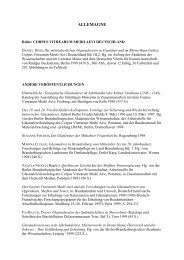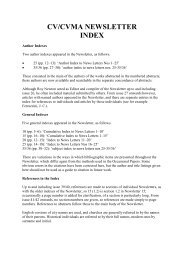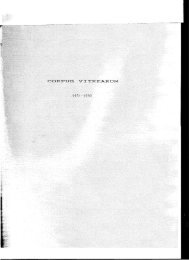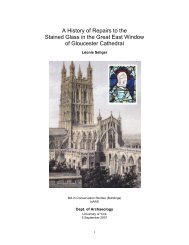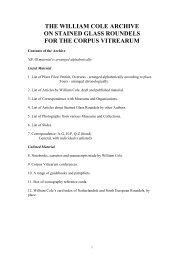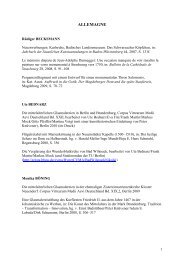BristolConference - Corpus Vitrearum Medii Aevi
BristolConference - Corpus Vitrearum Medii Aevi
BristolConference - Corpus Vitrearum Medii Aevi
You also want an ePaper? Increase the reach of your titles
YUMPU automatically turns print PDFs into web optimized ePapers that Google loves.
Prof. Nigel Morgan<br />
(Oslo University)<br />
Donors, Text Scrolls and Devotions in English Stained Glass and Manuscript Painting, c.1300-1450<br />
The inscribed scrolls presented by donors to Christ, the Virgin or the saint before whom<br />
they kneel are more varied in their texts and intentions than is commonly supposed. These<br />
simulate the spoken words of the donors, or alternatively they were viewed as written<br />
petitions, and they have received little systematic study. They provide evidence regarding<br />
devotional attitudes, prayer intentions, and are directed towards aid for the condition of<br />
the donors within this world, and also in their expectations for the afterlife. Examples from<br />
stained glass will be paralleled with others from illuminated manuscripts, whose<br />
accompanying prayers in the text provide additional information for interpretations of<br />
these images.<br />
Assoc. Prof. Elizabeth Pastan<br />
(Emory University, Atlanta)<br />
Secular Patronage in the Programme of the Paradisus Clausiralis: Indiana's Saint Catherine Seized<br />
for Martyrdom (c.1517) and the Glazed Cloister of Louoain<br />
A small, exquisitely detailed, early sixteenth-century stained glass panel of St Catherine<br />
Seized for Martyrdom, in Bloomington, Indiana, is one of the treasures first published in<br />
the checklists of American collections. Seminal studies by Vanden Bemden and Kerr<br />
(1983-84) and Wayment (1988, 1989) established the context for the panel. The style, size,<br />
and collecting history offer suggestive evidence that the St Catherine panel comes from<br />
the Charterhouse of Louvain. This paper will present the iconographic case for attribution<br />
to Louvain.<br />
While eighteenth-century chroniclers refer to a typological programme in the Great Cloister,<br />
Maes uncovered references and panels corresponding to a cycle of St Nicholas. Wayment<br />
further expanded the hagiographical programme by connecting panels from the life of<br />
St John with a document of 19 June 1517 that named John, Lord of Berg, as the donor of<br />
stained glass that the glazier Jan Diependale had been dilatory in completing. In the case<br />
of St Catherine, there is no established typological connection, but the scene from her<br />
martyrdom may be related to a particular donor named Catherine from the Boelen family<br />
of Amsterdam.<br />
14



